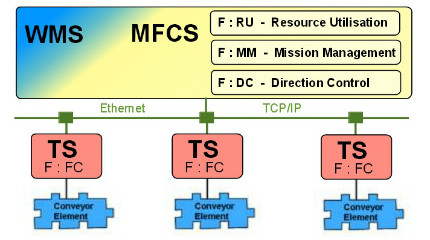The current market development shows the following challenges:
- New component technologies require new measures to be taken
- Uncoordinated function modelling leads to fragmentation
- Large projects can only be managed with extreme engineering effort
- Heterogeneous individuality in the implementation of new technologies is a step backwards
- Standardization through function modeling is necessary
The solution lies in a standardized modularization of the components based on a functional approach to the intralogistic overall system. To achieve this comprehensive standard, the first step is a clear segmentation of the materials handling technology functions. Due to this point of view the logistic processes are the center of considerations from the very beginning. The functional disassembly of an intralogistics system allows later system modeling with reusable building blocks, independent of the technology used. This approach forms the basis for the reduction of complexity, as each system element can subsequently be assigned to a function. The first stage of a hierarchy is formed, which creates clear rules for all processes in the facility. Examples of functions are resource utilization or transport order management (see also the methodology of VDI / VDMA SAIL.
In the next step, these defined functions are linked to corresponding facility components. A component is, for example, in its smallest form a conveying element. Thus the next step for a standardization is created and can take place now first for the individual components and then for their interfaces.
The advantages
The advantages of this function-centered facility modeling can be summarized as follows:
- Increased planning intelligence through a modular view of the facility in the planning phase.
- Uniform and clear definitions of terms.
- A transparent functions evaluation in the procurement phase
“Customer says what he wants – supplier says what he delivers”. - Project partners communicate on the same basis; this ensures a clear separation of functions in interdisciplinary cooperation during the realization phase.
- A clear interface definition at the module boundaries during the realization phase.
- The manufacturer is not bound to any conventions within the functions.
- High availability due to clear functional separation in the operating phase.
- Low-risk interchangeability of functionally separate sub-systems or components in the modernization phase.
A reusability of the encapsulated units
As a result, the new system architecture acts as a cost brake in the modulation of intralogistic material flow controls.
All in all, the high degree of reuse of the encapsulated functions offers a clear cost advantage through reduced adaptation effort, higher standardization, a more mature implementation level and shorter commissioning times.
Further information about SAIL and the conceptual steps towards a standardized system architecture can be found here.
Also available in Deutsch (German)
